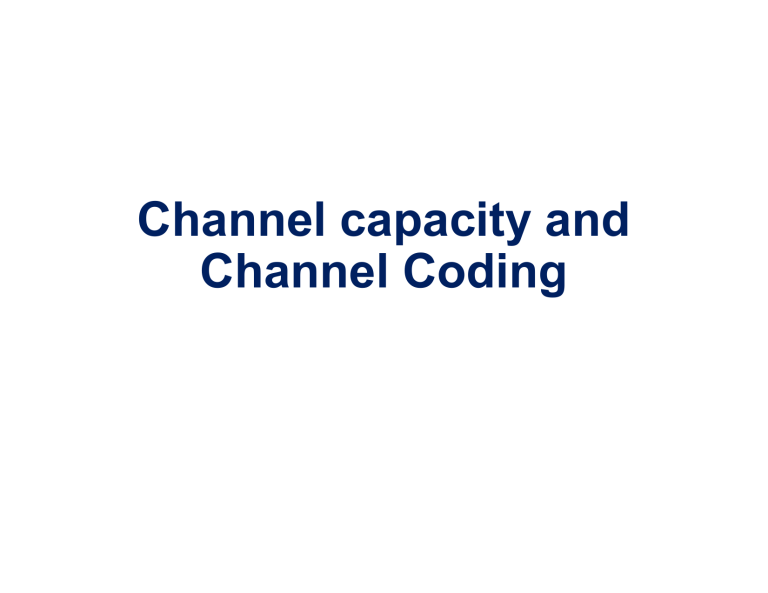
Channel capacity and Channel Coding Channel Coding in Digital Communication Systems Channel Coding - Definition • Information is transmitted through channels (eg. Wires, optical fibres and even air) • Error occurs in the transmitted signal due to the transmission in a nonideal channel. The signal power is also reduced. • Noise exists in channels • Noise signals corrupt the transmitted data • Class of signal transformations designed to improve communication performance by enabling the transmitted signals to better withstand channel distortions such as noise, interference, and fading. What is Coding? • Coding is the conversion of information to another form for some purpose. • Source Coding : The purpose is lowering the redundancy in the information. (e.g. ZIP, JPEG, MPEG2) • Channel Coding : The purpose is to overcome channel noise. Mathematical model of a channel • Assume that our input to the channel is , and the output is • Then the characteristics of the channel can be defined by its conditional probability distribution Information rate • If the time rate at which source ‘s’ emits symbols is r(symbol, s) the information rate ‘R’ of the source is given by here, =information rate is entropy is the rate at which symbols are generated. and Units: • is represented in average number of bits of information per second.it is calculated as =[ in symbols/sec]*[ in information bits/symbol] • =information bits/second Channel capacity and rate • The maximum rate at which we can transmit a message with very low probability of error and reconstruct the source message at the output is called the capacity of the channel. • Channel capacity is defined as the maximum possible value of the mutual information • We choose the best to maximize • For any rate , we can transmit information with arbitrarily small probability of error Discrete memory less channels(DMC) Definition Discrete channel :(X, p(y|x), Y) A system consisting of an input alphabet X and output alphabet Y (finite sets) and a probability transition matrix p(y|x) that expresses the probability of observing the output symbol y given that we send the symbol x. • The channel is said to be memoryless if the probability distribution of the output depends only on the input at that time and is conditionally independent of previous inputs or outputs. • Definition “information” channel capacity of a discrete memoryless channel: Bandwidth and channel capacity • The transmission of data over the channel depends upon two parameters , they are transmitted power and channel bandwidth. • A communication channel cannot propagate a signal that contains a frequency which is changing at a rate greater than bandwidth of the channel. • The greater the bandwidth available the higher the information carrying capacity. Shannon limit for channel capacity • Definition: The maximum data rate at which information can be transmitted over a given communication channel, under given condition is referred to as the channel capacity C=Blog2(1+S/N) bps • For a given level of noise, the data rate or capacity can be increased by increasing either bandwidth or signal strength. • If bandwidth B is increased , more noise is introduced to the system. Since noise is assumed to be white noise Thus as B increases, SNR decreases. Shannon limit for channel capacity • Shannon’s theorem says that if it is possible to transmit information without any error and if noise present coding techniques are used to correct and detect the errors. • Noise less channel has infinite capacity i..e, if then then • Infinite bandwidth channel has finite capacity. This is because as bandwidth increases noise power also increases i.e. • Due to this increase in noise power, signal to noise ratio decreases. Hence even if capacity does not approaches infinity. Shannon limit for channel capacity Channel Coding • Channel encoding : The application of redundant symbols to correct data errors. • Modulation : Conversion of symbols to a waveform for transmission. • Demodulation : Conversion of the waveform back to symbols, usually one at a time. • Decoding: Using the redundant symbols to correct errors. Introduction: Channel Coding Principle: Add redundancy to message sequence to minimize error rate Transmitter Source Receiver 1 1 0 1 Channel encoder 1 1 0 1 1 0 0 1 1 1 0 1 110 11 100 The channel encoder adds extra bits (redundancy)to message bits. The encoded signal is transmitted over the noisy channel Sink Channel Channel decoder The channel decoder identifies the redundant bits and uses them to detect and correct the errors in the message if any. ERROR CONTROL CODING • The redundant bits in the message are called check bits. Errors can be detected and corrected with the help of these bits. • It is not possible to detect and correct all the errors in the message . Errors up to certain limit can only be detected and corrected. There are two main methods used for error control coding 1) Forward error correction The key idea of FEC is to transmit enough redundant data to allow receiver to recover from errors all by itself. No sender retransmission required 2) Error detection with retransmission (ARC technique) • The check bits reduce the data rate through the channel. • Tradeoffs between: • Efficiency • Reliability • Encoding/Decoding complexity Modulo 2 addition/XOR 0 0 0 0 1 1 1 0 1 1 1 0 Linear Block Codes Key terms in error control coding • Block length : The number of bits the code. after coding is called the block length of • Code rate(r): the ratio of the message bits(k) and the encoder output bits “n” is called code rate. Code rate is defined by 0<r<1 • Channel data rate: it is the bit rate at the output of the encoder. if the bit rate at the input of the encoder is 𝑠 then the channel data rate will be 𝑜 𝑠 • Code efficiency: it is the ratio of message bits in a block to the transmitted bits for that block by the encoder. Efficiency= Linear Block Codes: Example Example: Find linear block code encoder G if code generator polynomial g(x)=1+x+x3 for a (7, 4) code; n = total number of bits = 7, k = number of information bits = 4, r = number of parity bits = n - k = 3 x3 p1 Re 1 x 110 3 1 x x x4 p2 Re x x 2 011 3 1 x x x5 p 3 Re 1 x x 2 111 3 1 x x x6 p4 Re 1 x 2 101 3 1 x x xnk i1 i P Remainder of , for i 1, 2, , k g ( x) 1000 | 110 0100 | 011 [ I | P] G 0010 | 111 0001 | 101 I is the identity matrix P is the parity matrix Linear Block Codes: Example The Generator Polynomial can be used to determine the Generator Matrix G that allows determination of parity bits for a given data bits of m by multiplying as follows: 1000110 0100011 [1011 | 100] c m.G [1011] 0010111 0001101 Data Data Parity Other combinations of m can be used to determine all other possible code words Block Codes: Linear Block Codes Message vector m Generator matrix G Code Vector C Air Parity check matrix HT Code Vector C Transmitter Receiver Operations of the generator matrix and the parity check matrix Consider a (7, 4) linear block code, given by G as 1000 0100 G 0010 0001 | 110 | 011 | 111 | 101 H T 1011 | 100 P 1110 | 010 I n k 0111 | 001 T For convenience, the code vector is expressed as c m | c p Where c p mP is an (n-k)-bit parity check vector Null vector 0 Types of Errors Single-bit error Burst error Parity Bit Parity Bit Example Even parity is more common (11,7) Hamming Code Example (11,7) Hamming Code Example (11,7) Hamming Code Example (11,7) Hamming Code Example Cyclic block codes • Cyclic codes are a subclass of linear block codes. • Encoding and syndrome calculation are easily performed using feedback shift-registers. • Hence, relatively long block codes can be implemented with a reasonable complexity. • BCH and Reed-Solomon codes are cyclic codes. Non-Systematic Cyclic code with Generator Polynomial Example: Generating of (7,4) non-systematic cyclic code, by generator polynomial G(p)=p3 +p+1 <- message <- generator <- encoded word The same result obtained by Maple: 56 Non-Systematic Cyclic code with Generator Matrix Non-Systematic Cyclic code with Generator Matrix Systematic Cyclic code with Generator Polynomial Systematic Cyclic code with Generator Matrix https://electronicsdesk.com/cyclic-code.html Division of the generated code by the generator polynomial leaves no reminder 3 2 G ( p ) p p 1 3 M ( p ) p p p 7 4 M ( p ) p 6 p 4 n k p 3 p 2 1 1 p M ( p) / G ( p) C ( p ) Q( p) n k 3 3 6 4 p M ( p ) C( p ) p ( p p ) 1 p p 1 Q( p )G ( p) ( p p 1)( p p 1) p p 1 p3 p2 1 p3 p2 1 p6 p 4 1 p6 p5 p3 p5 p 4 p3 1 p 5 p 4 This p 2can be used for error detection/correction as we inspect later p p 1 p3 p2 1 3 2 69


